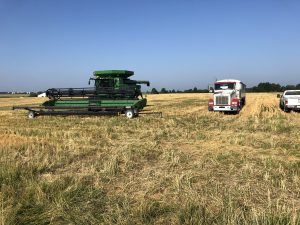 Davis County farmer Roger Wuthrich knows every growing season is different, but he dealt with some déjà vu at planting season. He’s battled excess moisture at planting three years running on his southeast Iowa farm, but by late July, the crops needed a drink.
Davis County farmer Roger Wuthrich knows every growing season is different, but he dealt with some déjà vu at planting season. He’s battled excess moisture at planting three years running on his southeast Iowa farm, but by late July, the crops needed a drink.
Wuthrich added several conservation practices like cover crops, no-till and terraces to keep the soil from moving on his highly erodible fields and he witnessed the benefits of those practices this spring. He has a unique perspective because he farms a combination of commercial and organic corn, soybeans and wheat.
With his varied crops and production practices he can do a side-by-side comparison of how no-tilled conventional fields with cover crops, organic fields with cover crops and tilled organic fields handle moisture. On rolling ground, no-till and cover crops show their value.
“Our organic fields are terraced, but there’s nothing you can do when a field’s been tilled and you’ve had a big rain,” he said. “It’ll start ponding and then flow over the tops of the terraces.”

To limit erosion, he has increased cover crops, especially on his organic ground, but anticipates a challenge getting it established this fall. “We finished replanting the organic corn on July 6,” he said. “We’re going to be harvesting pretty late, which will make planting the cover crop more challenging, but we will do our best.”
Wuthrich rotates corn, soybeans and winter wheat on his organic ground. “If my organic ground is going to wheat in the fall, the cover crop isn’t such an issue,” he said. “On the corn and soybean ground, though, I’m working to increase cover crops to improve organic matter, control weeds as well as sequester nutrients.”
With soils drying out in July, Wuthrich says the crops are in need of a rain. “We could still see near-average yields, but a lot depends on the weather,” he said. “Still, we are doing fine because the water-holding ability of no-tilled soils is a benefit. There is more moisture in the first 4 inches of my no-tilled fields than soil that has been worked. There are obvious benefits to no-till throughout the growing season.”
Wuthrich is still evaluating the weed control benefits of cover crops. “After the late 2019 harvest, we didn’t get cover crops established on as many acres as we would have liked,” he said. “This spring, where cover crops were established, I noticed reduced weed pressure – so I know it works. I just need to have a window this fall to gain experience across more fields.
“It’s worth it to keep trying,” he added. “4R Plus practices help me to be sustainable. It’s important to have these practices as part of my long-range plan to protect the soil.”
Click here to ask Roger a question about his farming operation.
